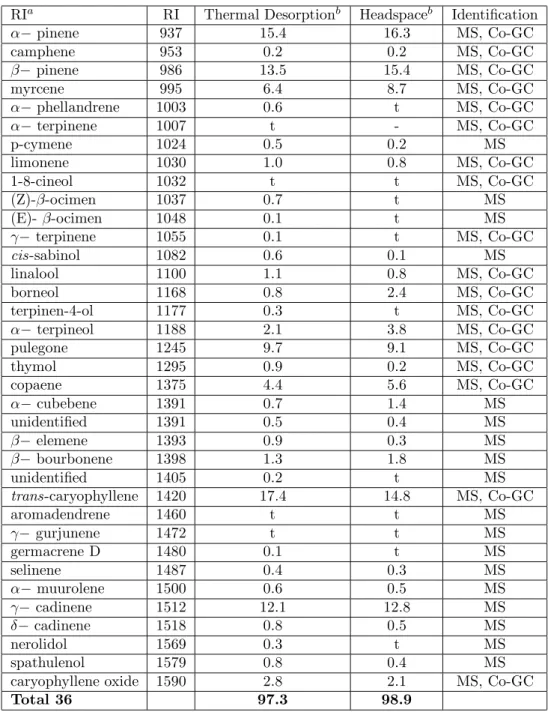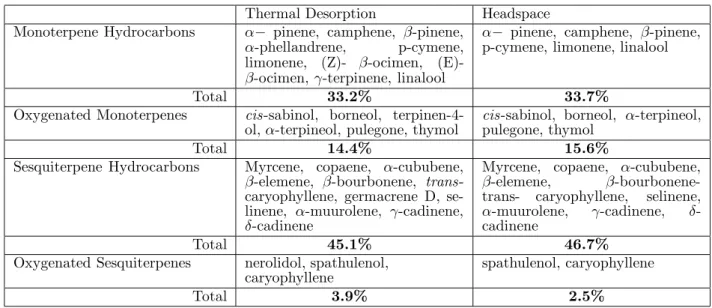T ¨UB˙ITAK
Analysis of the Essential Oil Composition of Sideritis
albiflora Using Direct Thermal Desorption and
Headspace GC-MS Techniques
G¨ula¸ctı TOPC¸ U1∗, Aslı BARLA1, Ahmet C. G ¨OREN2,G¨okhan B˙ILSEL2, Mine B˙ILSEL2, G¨ulendam T ¨UMEN3 1˙Istanbul University, Faculty of Pharmacy, 34116, Beyazit, ˙Istanbul-TURKEY
e-mail: gulacti topcu@hotmail.com
2T ¨UB˙ITAK, UME, Group of Chemistry, P.O. Box 54, 41470, Gebze-Kocaeli-TURKEY 3Balıkesir University, Arts and Science Faculty, Department of Biology,
10100, Balıkesir-TURKEY
Received 12.04.2005
The main constituents of Sideritis albiflora were found to be trans-caryophyllene, α-pinene, β-pinene, γ-cadinene, pulegone, and caryophyllene oxide by both thermal desorption GC/MS and headspace GC/MS techniques.
Key Words: Thermal desorption, headspace, GC/MS, essential oil, Sideritis albiflora Hub.-Mor.
Introduction
In Turkey, there are more than 11,000 wild flowering plant species, one-third of which are aromatic. Herbal tea consumption in Turkey is quite common, especially in rural areas. One of the most commonly used plants for herbal tea is the genus Sideritis, which is widespread particularly in Aegean and Mediterranian areas, and represented by 46 species with high endemism (∼=80%) in Turkey.1 Sideritis species are used in folk
medicine due to their antimicrobial, anti-inflammatory, antirheumatic, antispasmodic, digestive and diuretic activities2,3. To date over 15 Sideritis species have been investigated for their non-volatile constituents and
mainly ent-kaurane diterpenes4−8 have been isolated while 50 Sideritis species have been investigated for
their essential oil composition, most of them contain α or β-pinene or both as the main constituents9−18. Ba¸ser9,17 and Kırımer18 classified Sideritis essential oils based on their main components, and S. albiflora
was included in the sesquiterpene-rich ones, however, its whole essential composition was not presented previously; only the major component was given β-caryophyllene18. In fact, Sideritis species are not rich in
essential oil, but their smell and aroma are pleasant. In the present study, thermal desorber GC-MS and headspace GC-MS techniques were used for the analysis of essential oil from S. albiflora.
Experimental
Plant Material and Determination of Essential Oil
The aerial parts of Sideritis albiflora Hub.-Mor. were collected from Fethiye-Mu˘gla in July 2004 by Dr. T. Kılı¸c. The plant was identified by one of the authors, Prof. Dr. G.T¨umen, and a voucher specimen was deposited in the Herbarium of the Faculty of Pharmacy, Anadolu University (ESSE 10467).
Analysis of Essential Oil Composition by Thermal Desorption GC/MS
A Perkin-Elmer Turbomatrix ATD was used for thermal desorption analysis. The temperature program was as follows: tube 100 ◦C, transfer line 150 ◦C, valve 150 ◦C, trap low –30 ◦C (Tenax-TA was used for trapping), and trap high 280 ◦C. The pneumatic program was inlet split 50 mL/min, outlet split 20 mL/min, and desorb 10 mL/min. The time program was tube desorb 10 min, and trap hold 5 min. For the capillary GC-MS analysis, a Fisons model 8000 series gas chromatograph connected to a Fisons model MD800 mass spectrometer was used. The temperature programs were 60 to 260◦C at a rate of 3◦C/min,and held isothermally for 20 min. High purity helium was used as carrier gas (20 psi) and an HP5-MS capillary column (30 m, 0.25 mm, 0.5 µm) was employed. The ion source and transfer line temperatures were maintained at 200 and 250◦C, respectively. Electron ionization MS in the range 50-400 Da was recorded at 70 eV energy with an ionization current of 200 µA. The scan time was 0.5 ms, and the multiplier potential was 300 V. Dried and powdered S. albiflora (35 µg) was put in a sample tube, and the analysis was started using the above conditions.
Analysis of Essential Oil Composition by Headspace GC/MS
A Thermo HS2000 was used for Headspace analysis. The analysis program and conditions were as follows: the vial oven temperatures were 140◦C, and needle temperatures were 25◦C and then 165◦C, respectively. Oven time with the shaker was 20 min, and injection volume was 1 mL.
Identification of Components
The components were identified by comparision of their mass spectra with the Wiley and NIST GC-MS libraries and T ¨UB˙ITAK UME library of essential oil constituents and with authentic samples. The authentic samples were obtained from ULTRAkit r WRK-105 Terpenes (ULTRA Scientific, North Kingstown, RI, USA) and 1,8-cineole (98%), linalool oxide (97%) and caryophyllene oxide (99%) purchased from Fluka, and thymol (97%) purchased from Merck. Percentage amounts of separated compounds were calculated automatically from peak areas of total ion chromatograms (TIC). n-Alkanes were used as reference points in the calculation of relative retention indices (RRI). The volatile compounds identified in the leaves of S.
albiflora are seen in Table 1.
Results and Discussion
Over the last decade, for the analysis of essential oils, head-space GC-MS has become a common technique, while analyses by thermal desorber coupled with GC-MS have been exemplified by a limited number of studies19−21.
Table 1. Chemical composition of essential oil of Sideritis albiflora obtained by direct thermal desorber and
headspace GC-MS techniques.
RIa RI Thermal Desorptionb Headspaceb Identification
α− pinene 937 15.4 16.3 MS, Co-GC camphene 953 0.2 0.2 MS, Co-GC β− pinene 986 13.5 15.4 MS, Co-GC myrcene 995 6.4 8.7 MS, Co-GC α− phellandrene 1003 0.6 t MS, Co-GC α− terpinene 1007 t - MS, Co-GC p-cymene 1024 0.5 0.2 MS limonene 1030 1.0 0.8 MS, Co-GC 1-8-cineol 1032 t t MS, Co-GC (Z)-β-ocimen 1037 0.7 t MS (E)- β-ocimen 1048 0.1 t MS γ− terpinene 1055 0.1 t MS, Co-GC cis-sabinol 1082 0.6 0.1 MS linalool 1100 1.1 0.8 MS, Co-GC borneol 1168 0.8 2.4 MS, Co-GC terpinen-4-ol 1177 0.3 t MS, Co-GC α− terpineol 1188 2.1 3.8 MS, Co-GC pulegone 1245 9.7 9.1 MS, Co-GC thymol 1295 0.9 0.2 MS, Co-GC copaene 1375 4.4 5.6 MS, Co-GC α− cubebene 1391 0.7 1.4 MS unidentified 1391 0.5 0.4 MS β− elemene 1393 0.9 0.3 MS β− bourbonene 1398 1.3 1.8 MS unidentified 1405 0.2 t MS trans-caryophyllene 1420 17.4 14.8 MS, Co-GC aromadendrene 1460 t t MS γ− gurjunene 1472 t t MS germacrene D 1480 0.1 t MS selinene 1487 0.4 0.3 MS α− muurolene 1500 0.6 0.5 MS γ− cadinene 1512 12.1 12.8 MS δ− cadinene 1518 0.8 0.5 MS nerolidol 1569 0.3 t MS spathulenol 1579 0.8 0.4 MS
caryophyllene oxide 1590 2.8 2.1 MS, Co-GC
Total 36 97.3 98.9
aRI =retention indices relative to C
9-C24n-alkanes on the HP5-MS column. bPercentages were calculated from TIC.
t < 0.1
Essential oil analysis of S. albiflora by a thermal desorber coupled with a GC-MS spectrometer afforded 36 constituents (Table 1). The main constituents of S. albiflora were trans-caryophyllene (17.4%),
α-pinene (15.4%), β-pinene (13.5%), γ-cadinene (12.1%) pulegone (9.7%), myrcene (6.5%), copaene (4.4%)
Secondly, we analyzed the essential oil of the plant by headspace GC-MS, which yielded results similar to those of thermal desorption (Tables 1 and 2). There were small differences in the percentages of trans-caryophyllene (14.8%), α-pinene (16.3%), β-pinene (15.4%), γ-cadinene (12.8%), pulegone (9.1%), myrcene (8.7%), copaene (5.6%) and caryophyllene oxide (2.1%) (Table 1).
Table 2. Essential oil composition of Sideritis albiflora classified as mono- and sesqui-terpenes.
Thermal Desorption Headspace Monoterpene Hydrocarbons α− pinene, camphene, β-pinene,
α-phellandrene, p-cymene, limonene, (Z)- β-ocimen,
(E)-β-ocimen, γ-terpinene, linalool
α− pinene, camphene, β-pinene,
p-cymene, limonene, linalool
Total 33.2% 33.7%
Oxygenated Monoterpenes cis-sabinol, borneol,
terpinen-4-ol, α-terpineterpinen-4-ol, pulegone, thymol cis-sabinol, borneol, α-terpineol,pulegone, thymol
Total 14.4% 15.6%
Sesquiterpene Hydrocarbons Myrcene, copaene, α-cububene,
β-elemene, β-bourbonene,
trans-caryophyllene, germacrene D, se-linene, α-muurolene, γ-cadinene,
δ-cadinene
Myrcene, copaene, α-cububene,
β-elemene,
β-bourbonene-trans- caryophyllene, selinene,
α-muurolene, γ-cadinene,
δ-cadinene
Total 45.1% 46.7%
Oxygenated Sesquiterpenes nerolidol, spathulenol,
caryophyllene spathulenol, caryophyllene
Total 3.9% 2.5%
In conclusion, in both techniques the essential oil was most rich in sesquiterpene hydrocarbons (namely trans-caryophyllene and γ-cadinene), followed by monoterpene hydrocarbons. However, by thermal desorption and headspace techniques, total amounts of monoterpenes (hydrocarbons and oxygenated), were 47.7% and 49.3% and total amounts of sesquiterpenes (hydrocarbons and oxygenated) were 49.0% and 49.2%, respectively, which were almost equal (Table 2).
Acknowledgments
G. Topcu thanks the ˙Istanbul University Research Foundation for its support (Project No: UDP-64).
References
1. A. Huber-Morath, Sideritis in Flora of Turkey and East Aegean Islands, Vol 7.,Ed. P.H. Davis. Edinburgh University Press, Edinburgh, 1982; 178.
2. E. Sezik and N. Ezer, Turk. J. Chem. 7, 163-167 (1983).
3. E. Ye¸silada and N. Ezer, Int. J. Crude Drug Res. 27, 38-40 (1989).
4. K.H.C. Ba¸ser, M.L. Bondi, M. Bruno, N. Kırımer, F. Piozzi, G. T¨umen and N. Vasallo, Phytochemistry 43, 1293-1296 (1996).
5. G. Topcu, A.C. G¨oren, Y.K. Yıldız and G. T¨umen, Nat. Prod. Lett. 14, 123-129 (1999). 6. G. Topcu, A.C. G¨oren, T. Kılı¸c, Y.K. Yıldız and G. T¨umen, Fitoterapia. 72, 1-4 (2001).
7. G. Topcu, A.C. G¨oren, T. Kılı¸c, Y.K. Yıldız and G. T¨umen. Nat. Prod. Lett. 16, 33- 37 (2002). 8. G. Topcu, A.C. G¨oren, T. Kılı¸c, Y.K. Yıldız and G. T¨umen, Turk. J. Chem. 26, 189-194 (2002).
9. K.H.C. Ba¸ser (Editor). Proceedings of the 13th International Congress of Flavours, Fragrances and Essential Oils; in Flavours, Fragrances and Essential Oils Congress, ˙Istanbul, Turkey, 15-19 October 1995, AREP Publ.,
˙Istanbul, Turkey.
10. N. Ezer, R. Villa, S. Canigueral and T. Adzet, Phytochemistry 41: 203-205 (1996).
11. N. Kırımer, N. Tabanca, G. T¨umen, H. Duman and K.H.C. Ba¸ser, Flavour Frag J. 14, 421-425 (1999) 12. N. Kırımer, N. Tabanca, K.H.C. Ba¸ser and G. T¨umen, J. Essent. Oil Res. 13, 132-133 (2001).
13. N. Kırımer, N. Tabanca, B. Demirci, K.H.C. Ba¸ser, H. Duman and Z. Ayta¸c, Chem. Nat. Compd. 37, 234-237 (2001).
14. N. Kırımer, N. Tabanca, T. ¨Ozek, K.H.C. Ba¸ser, G. T¨umen and H. Duman, J. Essent. Oil Res. 15, 221-225 (2003).
15. N. Tabanca, N. Kırımer and K.H.C. Ba¸ser. Turk. J. Chem. 25, 201-208 (2001). 16. M. ¨Ozcan, J.C. Chalcat and A. Akg¨ul, Food Chem. 75, 459-463 (2001). 17. K.H.C. Ba¸ser, Pure and Appl. Chem. 74, 527-545 (2002).
18. N. Kırımer, K.H.C. Baser, B. Demirel and H. Duman, Chem. Nat. Compd. 40, 19-23 (2004) 19. T.G. Hartman, K. Karmas and N.J. Chen, Acs. Sym. Ser. 506, 60-76 (1992).
20. A. Bianchi and H.A. Cook, J. Chromatography A. 449, 175-181 (1998).
21. A.C. G¨oren, G. Top¸cu, G. Bilsel, M. Bilsel, J.M. Wilkinson and H.A. Cavanagh, Nat. Prod. Res. 18, 189-195 (2004).

